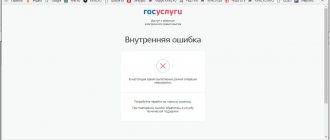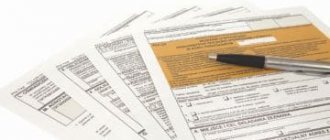When preparing tax returns, even qualified specialists with many years of experience enter erroneous data. In order to protect the enterprise from penalties and not have to resort to writing explanatory papers, professionals advise working with control ratios to identify errors. How to check 6-NDFL and what reconciliation methods have been developed - read on.
How to check 6-NDFL
Features of the 6-NDFL report
This type of accounting documentation is relatively new, introduced in 2021.
6-NDFL is a mandatory reporting document. The information contained in it concerns employee profits and accrued income tax.
The form must be submitted to the Federal Tax Service quarterly. One of the features is the entry of some data on an accrual basis, which is due to the specifics of wage payment. It is transferred in the month following the month of accrual. Due to the fact that profits are paid in the next month, there are time gaps between the day the tax is withheld and the day the wages are paid. If the first days of the month are non-working days, the gaps that arise between these dates are very significant. The next difference is the presence of information contained in other reporting documents, which allows you to compare and reconcile data.
How to take into account surcharges?
An organization may provide employees with a one-time additional payment for vacation. These charges should be reflected in the report. The date of transfer of funds is the date of payment of income (p. 100). Deductions are made at the time of payment of income, and transfers are made maximum the next day.
Example. The organization paid an additional 22 thousand rubles. employee 23.08. On the same day, tax was withheld in the amount of 2.8 thousand rubles. Let's reflect this in the report:
- Page 100 – August 23.
- Page 110 – August 23.
- Page 120 – August 23.
- Page 130 – 22 thousand rubles.
- Page 140 – 2.8 thousand rubles.
Control ratios
Each type of reporting allows the use of control ratios. This term refers to the correspondence of the numeric data of a certain row to the total value of other rows. In some cases, reconciliation takes place according to the “more or less” principle: it is important that the numbers entered in one column are more or less than the data indicated in other sections.
The control ratios applied to 6-NDFL require reconciliation between the 2-NDFL and DAM forms. In addition, representatives of the tax office carry out an audit based on a comparison of data inside the form.
In June 2021, the Federal Tax Service updated the formulas used for reconciliations. Most of the checkpoints are the same as previous versions. According to the rules of the new edition, the inspector will take into account the report even without the necessary correlation between the lines. The reason for refusal to accept Form 6-NDFL may be:
- discrepancy in the amounts of contributions in section 1;
- discrepancy between the amounts of contributions under section 3.
In order not to waste time on preparing corrective statements, you must first pay attention to these sections and check the report according to the established formulas.
Briefly about reporting
6-NDFL is a quarterly income tax report. It contains summary data from 2-NDFL certificates. According to the new rules, enterprises began reporting in 2021. The government not only introduced a new report, but also found a way to stimulate violators. Failure to provide data on time may result in account blocking.
Reporting was developed in order to strengthen control over the correctness and completeness of tax payment by enterprises. The document contains information about accruals and payments for all employees of the organization. Tax agents are companies that pay salaries to employees. They also provide reports to the Federal Tax Service at their location.
The document can be submitted in printed or electronic form. But this right of choice is available only to companies with up to 25 employees. All other organizations will have to report electronically. The date of submission of the report is considered:
- the day the printed report is submitted to the Federal Tax Service or the day the letter is sent by mail;
- the day of receipt of confirmation of sending the electronic document.
Applying benchmark ratios within a report
Accounting programs primarily reconcile data within a form without using additional sources.
Table 1. Reconciliation
| Right | Wrong |
| 020 = > 030 | 020 |
| 040 = ((020 - 030) x 010): 100 | 040 ≠ ((020 - 030) x 010): 100 |
| 020 - 025 ≥ 050 section 1.1 | 020 — 025 |
According to previous test ratios, the reconciliation of personal income tax profits took place taking into account the data in line 030. This method was not effective. Due to the fact that this column contains information about child benefits that should not be displayed in column 020, discrepancies inevitably arise during comparison. To display the data more correctly, inspectors check the tax base for contributions based on personal income tax profits minus dividends: it is necessary that the profit either equals or exceeds the tax base.
Table 2. Applications of control ratios
| Line | Reconciliation subject | Note |
| 010 | The total data must be greater than or equal to one of the components of the consumable part | The total amount of benefits paid should not be less than its part |
| 030 | If the number in column 1 of line 30 is greater than zero, check for the presence of indicators in columns 2 and 3 | If there were insured events, then the number in column 1 must be greater than zero |
| 060 | The relationship between total data and sums of parts | Line 060 ≥ sum of lines 061 and 062 |
If inconsistencies are identified in the provided form 6-NDFL, representatives of the competent authorities will require clarification
When checking line 040, it is necessary to take into account the possible error caused by rounding of data. Example:
- Initial data: number of employees - 30 people;
- total income for 8 months - 352,455 rubles;
- the amount of tax deductions is 32,000 rubles;
- withheld personal income tax - 37,070 rubles.
Simple math
To calculate the amount of tax, the income received for a certain period is multiplied by the tax rate, and, in the vast majority of cases, the resulting final value will not be an integer, and will contain numbers after the decimal point.
Since the tax indicator is reflected in whole rubles, the amount resulting from the calculation is rounded. Rounding of the accrued amount, in accordance with clause 6 of Art. 52 of the Tax Code of the Russian Federation, is carried out according to the classical mathematical rule: if the value of kopecks (digits after the decimal point) is less than 50, the kopecks should be discarded; if the resulting result after the decimal point forms the value “50” or higher, fractional signs are rounded up to the whole number ( up to a full ruble).
Let's look at examples:
- The initial amount of income is 48,372 rubles. With a tax rate of 13%, the result of the calculations will be 6,288.36 rubles. (48,372 x 13%), and the tax amount is 6,288 rubles. The 36 kopecks received during the calculation are discarded in this case.
- Income of an individual – 54,904 rubles. We multiply by the tax rate of 13%, the total will be 7,137.52 rubles. (54,904 x 13%), and as a result of rounding the indicator, the tax is equal to 7,138 rubles. The 52 kopecks formed as a result of a mathematical operation are rounded to the nearest ruble.
Personal income tax is also transferred in full rubles without kopecks.
Reconciliation of data in form 6-NDFL with information in form 2-NDFL
Due to the fact that 2-NDFL is issued for each employee separately, it is imperative to check the equality between the indicator in line 060 of 6-NDFL and the number of issued 2-NDFL.
Table 3. Control ratios between 6-NDFL and 2-NDFL
| Line 6-NDFL | Title of section 2-NDFL (total for each employee) |
| 020 | Total income |
| 025 | Profit from dividends |
| 040 | Calculated tax amount |
| 080 | Amount of tax not withheld by the tax agent |
| 060 | Number of issued certificates |
Rounding of 3NDFL tax.
Tax rounding 3NDFL - these are the rules and requirements for rounding tax amounts received to the full ruble. In the tax return in form 3-NDFL, all indicators must be left in the form in which they were received, i.e. with kopecks, however, there is an exception - the total amount of tax and advance payments are made in rounded form.
It should also be noted that the income of an individual that was received from non-Russian sources, and the tax that is paid on this income in a foreign country, is submitted to the declaration first in foreign currency, and then translated into rubles and kopecks (clause 1.6 of the Procedure for filling Form 3-NDFL, approved by Order of the Federal Tax Service dated December 24, 2014 No. ММВ-7-11/).
Reconciliation of data from form 6-NDFL and RSV
Since these types of certificates relate to reports on employees, it is natural to assume that many indicators from these reports should match.
The Federal Tax Service offers one control ratio between the lines: the difference between 020 and 025 6-NDFL should not be less than 030 of section 1.1 of the RSV.
We should not forget that if an organization submits 6-NDFL to the inspection, it must also submit the DAM
Are there any changes planned in the near future?
Personal income tax 13%
The basic rule that the legislator recommends to use is ordinary arithmetic rounding. Even if the calculation result has to be rounded down, this will not lead to tax arrears. This happens if only for the simple reason that there is a difference in alignment up or down.
For example, if the tax base for calculating a resident citizen for the specified period was 25,220 rubles. According to the Tax Code, it is necessary to apply a rate to withhold budget income of 13%. The result of the calculation is 3,278.60. Consequently, the amount of 3,279 rubles will be included in the declaration.
According to reviews of legal portals, no changes are expected regarding the procedure for calculating personal income tax (PIT). This means that the algorithm and the result of accruals do not raise any complaints from regulatory authorities. Also, integer numbers are processed faster by specialized programs within which the Tax Service operates. In 2021 and subsequent years, everything remains at the same level, as well as the procedure for rounding the obtained values of the mandatory fee.
Explanations for data discrepancies
If during the inspection the inspector finds errors, he has the right to charge additional mandatory contributions to the state treasury, apply administrative penalties in the form of a fine or penalty, or request an explanatory letter.
The inspector has the right to send a request for explanations even if he has not identified any serious errors. Inconsistency of data when reconciling control ratios may be the subject of an explanatory note, but is not considered a violation. Such discrepancies are often caused by carryover payments in the form of accrued but not transferred fees under contract agreements, for example. The tax office's request must be responded to within 5 business days. In case of delay in explanation, a fine of 5,000 rubles may be assessed.
Having mastered the principle of working with control ratios, an accountant will be able to identify miscalculations before submitting reports to the Federal Tax Service and protect the company from the application of penalties.
Example 3
Let's add the conditions of the previous example. In addition to salary and sick leave, the employee also received vacation pay in the amount of 15 thousand rubles on September 15, from which a fee of 1.95 thousand rubles was withheld.
Section 1 is also filled in by summing all amounts:
Page 020 – 1000 + 10 + 15 = 1025 thousand rubles.
Page 040 - 130 + 1.3 + 1.95 = 133.25 thousand rubles.
Page 070 - 130 + 1.3 + 1.95 = 133.25 thousand rubles.
The deadline for paying taxes on vacation pay and sick leave is the last day of the month. However, the moment at which income is received varies. Therefore, Section 2 is filled in two blocks. The first one was presented earlier. Now let’s add information on vacation pay to the report:
Page 100 – payment on September 15.
Page 110 – hold on September 15.
Page 120 – payment of tax on September 30.
Page 130 - the amount of accruals is 15 thousand rubles.
Page 140 – personal income tax 1.95 thousand rubles.
How to fill out a zero declaration
If an organization or individual entrepreneur does not have employees, then the enterprise does not report. The situation is the same if the organization sent employees on vacation or stopped operations. It's another matter if there are gaps in income accrual. For example, an enterprise did not accrue income in the first half of the year, but did accrue it in the second. In this case, reporting for 3 and 6 months is not necessary, but reporting for 9 and 12 months is required. To avoid problems with regulatory authorities, even in such a situation, some enterprises prefer to draw up letters and provide zero reporting for the first half of the year.
The reporting deadline is standard - the last day of the month following the reporting month. In 2021 this is:
- May 2 – to submit the report for the first quarter;
- June 31 – to submit the half-year report;
- October 30 – to submit the report for the third quarter.
How to fill out the report? Enter “0” or dashes in all columns.








